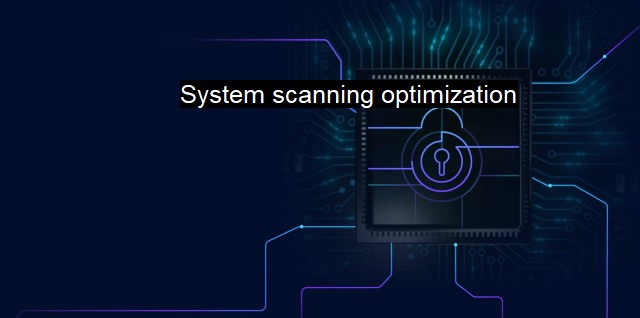What is System scanning optimization?
Enhancing Cybersecurity with System Scanning Optimization: Improving Antivirus and Malware Detection
System scanning optimization refers to the process of enhancing the efficiency and effectiveness of security systems used to detect and eliminate cyber threats. In the cybersecurity and antivirus context, system scanning optimization focuses on reducing the time taken by security systems in scanning computer systems for potential threats and the resources required. To remain secure while also not significantly compromising performance, antivirus software should perform cost-effective and efficient system scanning for malware.To attain optimized system scanning, various factors are incorporated. Firstly and most one needs the right scanning technology. In cybersecurity and antivirus systems, there are various forms of scanning technologies, such as signature-based and heuristic scanning methods. Signature-based scanning is the traditional method where your system correlates all your files with a database containing millions of known malware signatures. It's faster but doesn't recognize unknown threats (zero-day attacks). On the other hand, heuristic scanning is where the scanner checks your files' behaviors and code structures for any suspicious activities. This method recognizes unknown malware but is slower, as it scans effectively to enhance security.
There is cloud-based scanning, where some of the scanning activities are transferred from your local system to an online cloud. Therefore, this increases the performance of your device, as much of the processing need not take place on your computer. By taking advantage of these innovations, system scanning optimization is achievable, thus enhancing overall security.
Timing is another critical aspect of system scanning optimization. It's crucial to program the security systems in a way that minimizes disruption to the user. Usually, the depth and frequency of the scan are inversely related - as in, the more often that scans occur, the less deep they need to be, and vice versa. Therefore, system scanning optimization schedules in-depth scans during non-peak hours, inherently boosting the productivity of the system involved.
System scanning optimization also tailors the tool functionalities as per the vulnerability and the threat landscape of an infrastructure. For instance, scanning few critical areas/modules sensitive to threats could lead to a reduction in scanning times while enhancing mitigation and defense of cyber threats.
System scanning optimization are concerned with scanning system files periodically, instead of continuously checking for threats, as it strikes the much-needed balance between security and performance. If an antivirus were to check all files continuously, it could undermine the operating system's performance. Instead, optimized scanning integrates real-time scanning of possibly vulnerable areas, such as the downloading or opening of files, with periodic full system scans to achieve a smooth trade-off between security and performance.
On the other hand, system scanning optimization strategies are also about tuning the scan in a way that it creates minimum performance degradation. Antivirus products must be configured correctly to prevent them from scanning unneeded files (such as backup copies) or legitimate network traffic that would never harbor a virus. This type of optimization can improve efficiency and reduce the performance impact on the system or network.
System scanning optimization is about appropriately configuring and managing these critical factors in the system's scanning protocol. It involves utilizing cutting-edge technologies, employing adaptive time management and scheduling, and structuring system resources optimally. Through this process, you can tackle cybersecurity threats, keep malware and viruses at bay, and secure your systems effectively while simultaneously maintaining system performance at an optimal level. All in all, achieving system scanning optimization may seem challenging, but it's significantly vital in augmenting cybersecurity effectiveness.

System scanning optimization FAQs
What is system scanning optimization?
System scanning optimization is a cybersecurity strategy that focuses on optimizing the antivirus scanning process to improve system performance without compromising security.Why is system scanning optimization important?
System scanning optimization is important because it helps improve system performance and reduces the impact of antivirus software on system resources. It also helps ensure that the antivirus scans do not interfere with other critical system processes, such as backups and updates.What are the benefits of system scanning optimization?
The benefits of system scanning optimization include improved system performance, reduced resource consumption, reduced impact on system processes, and more efficient use of antivirus software. This can help improve overall system security and reduce the risk of cyberattacks.How can I optimize system scanning in my organization?
To optimize system scanning in your organization, you can implement a range of strategies, including scheduling antivirus scans outside of business hours, optimizing scan settings to reduce resource consumption, and prioritizing scans based on criticality. You can also consider investing in specialized tools and technologies designed to optimize system scanning for cybersecurity purposes.| | A | | | B | | | C | | | D | | | E | | | F | | | G | | | H | | | I | | | J | | | K | | | L | | | M | |
| | N | | | O | | | P | | | Q | | | R | | | S | | | T | | | U | | | V | | | W | | | X | | | Y | | | Z | |
| | 1 | | | 2 | | | 3 | | | 4 | | | 7 | | | 8 | | |||||||